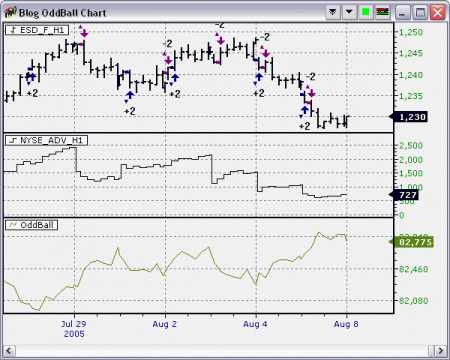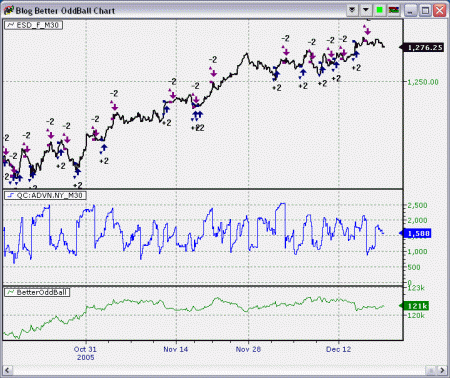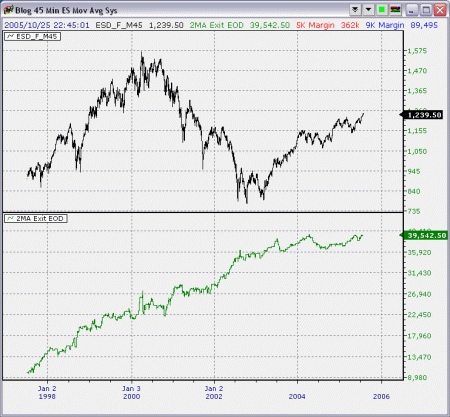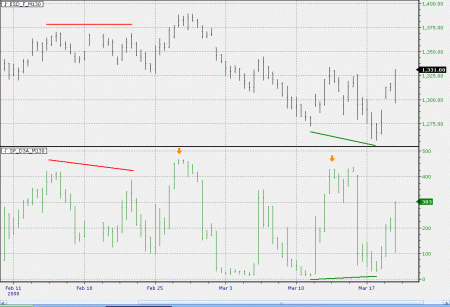Defensive Money Management Explained (Part 6) – The Crash and Burn of a Winning Trading Model

Written by Lawrence Chan. All rights reserved.
Note: Feel free to email me with your feedback lawrence@daytradingbias.com
To illustrate the importance of deleveraging overtime on any particular trading model that depends on trading edge based on entry signals, here is a case study of an interesting trading model.
Let’s examine the following chart first.
The red line above shows the net profit of a day trading model on emini S&P. It trades only 20 to 30 times a year. Profitability is very consistent over the years and its winning percentage swings around 50% until 2008.
It is a short only signal. Surprising, isn’t it?
Most of you must be very curious about the exact trading model. Don’t worry I will talk about that in details a bit later.
The Winning Years
As you can see, the model works all the way since 1990s. A slightly more sophisticated version of the model works since late 1980s.
If you have been trading this model as late as 2004, you will still get a great run from the model.
If you run a hedge fund, there is no reason why you should not bet your farm on this. Well, hedgies may throw out terms like Kelly formula, optimal f, etc. but we all know it is just finding an excuse in applying maximum leverage (that should not blow the fund up based on historical performance) and hope for the best. Thus the performance of your fund would be exponential better than the one I’ve shown here which stick to a single contract.
The Crash and Burn Years
During year 2008 and 2009, the winning percentage of the model dropped to less than 30%. That, coupled with extremely wide range during the time period, totally destroyed the system.
If you started out trading the model during 2007, your expectation of the model is high and you will be wiped out for sure no matter how defensive you are, unless you have applied the concept of absolute equity stop on the model.
If you started out trading the model with at least a few good years beforehand, as long as you deleverage (i.e. reducing the use of margin in trading the model over time), or, having absolute equity stop (i.e. 20% of equity committed behind the model), you will be able to survive this crushing period.
From the chart above, it is clear at least 50% of the total accumulated profit is wiped out if you simply let the model do what it does.
How many traders and funds are prepared in handling a disastrous scenario this way? Not many.
I am disclosing this model here to show everyone, and especially those who focus a lot on discovery of trading edge thru entry signals, that successful trading models can fail and it can happen very quickly.
The Recovery
Since 2010 the model has returned to its normal 50% winning rate and recovered somewhat.
Can it recover fully? I have no idea as the edge it depends on could be gone already.
My disclosure of the model here, if words spread around, will likely accelerate the discount process of the edge.
That we have to wait and see.
The Model
Using RTH only Emini S&P data, excluding the last 15 minutes after 4 pm, you get a data series of daily bars.
When 3 period simple moving average on close crosses below the 7 period simple moving average on close, short the next trading day from open and close the trade by 4 pm.
No more rules. It is that simple.
You can improve the model in so many different ways, allowing you to extract more money from the market using this entry as the foundation. But such variations will not save you from the crash and burn period. The more optimized these models are to capture more profit, the more likely they would amplify the losses during the crash and burn period.
The reason for this simple concept to work so well is that many funds and traders use moving average based trading models. Thus the pattern emerges from their aggregated actions while they participated in the market. It is not a system trying to outsmart the other participants. Instead, it jumps in on those days most other players would do the same. The logic behind is simple, but most people do not recognize that many great trading signals work that way. This is what I mean by trading edge based on entry.
The same reason for the success of this model is also the reason why it was crushed so bad in 2008 and 2009. Well known market force PPT knows very well what most market participants do and during that 2 years, they choose to intervene the markets at times where they can get the impact maximized. Hence, massive short squeezes were coordinated on trading days that had every technical and fundamental reasons to go lower.
End Notes
This raw signal was in use by at least 2 large funds I know of, both of which have retired the signal since 2009.
And to those who tried to guard this signal as a secret – bite me.
– end of part 6 –

















“as long as you deleverage, or, having absolute equity stop…”
Is there an argument here for trading off the equity curve? In your example, I notice equity continues up over two bull cycles and one bear cycle. Might one draw a trend line under the equity curve, and if penetrated, resolve not to trade the system until it makes a new equity high? Or something like that?
We draw trend lines on bar charts. Is it viable to draw a trend line on an equity curve?
I really don’t know. I am just wondering. I guess it would be the same as adding another filter to the system, and so reduce your degrees of freedom by one.
(BTW, these articles are pretty good. You can’t just read them; you kind of have to study them. I have read all of the old NeoTicker blog articles too, several times.)
“And to those who tried to guard this signal as a secret – bite me.”
You tell ’em, Lawrence!
I have pretty extensive work on equity curve management back in the late 90s.
It works best if you know the driver of the model.
So in this situation, we have a raw model that isolate the edge from entry is the best case scenario. The moment you see the model falling flat in 6 months you have to pull the plug.